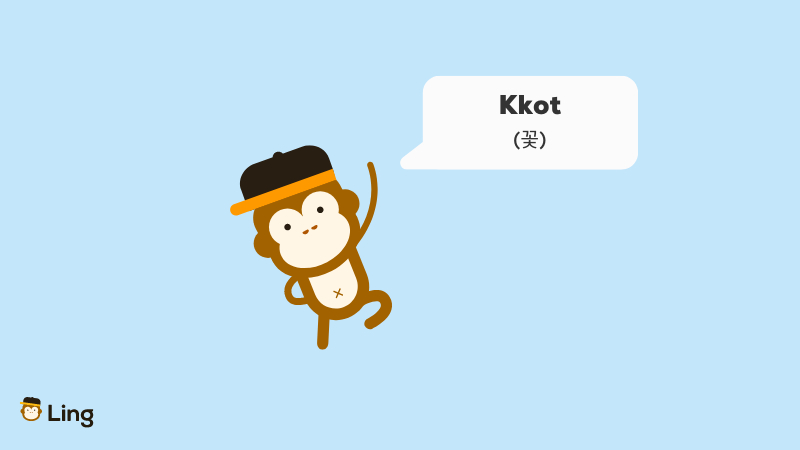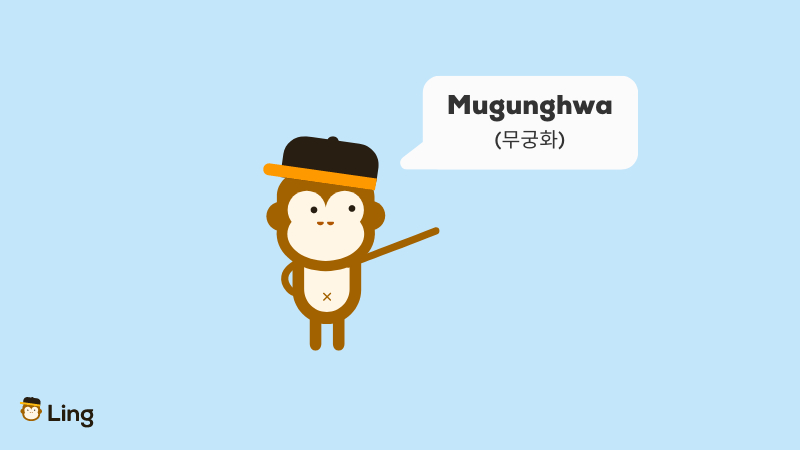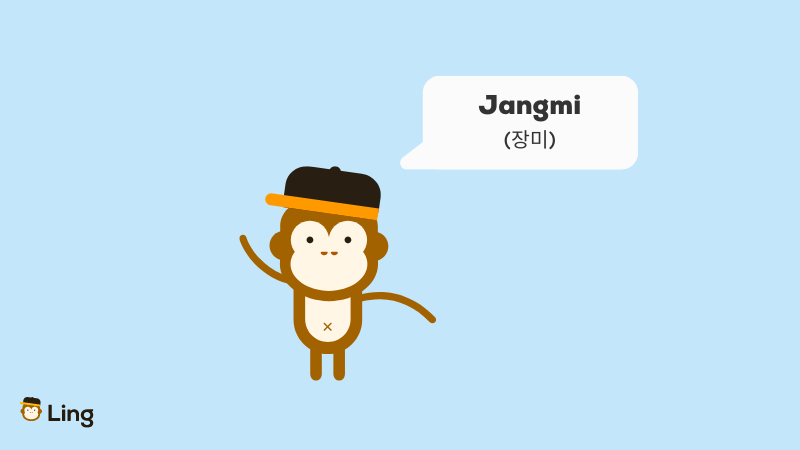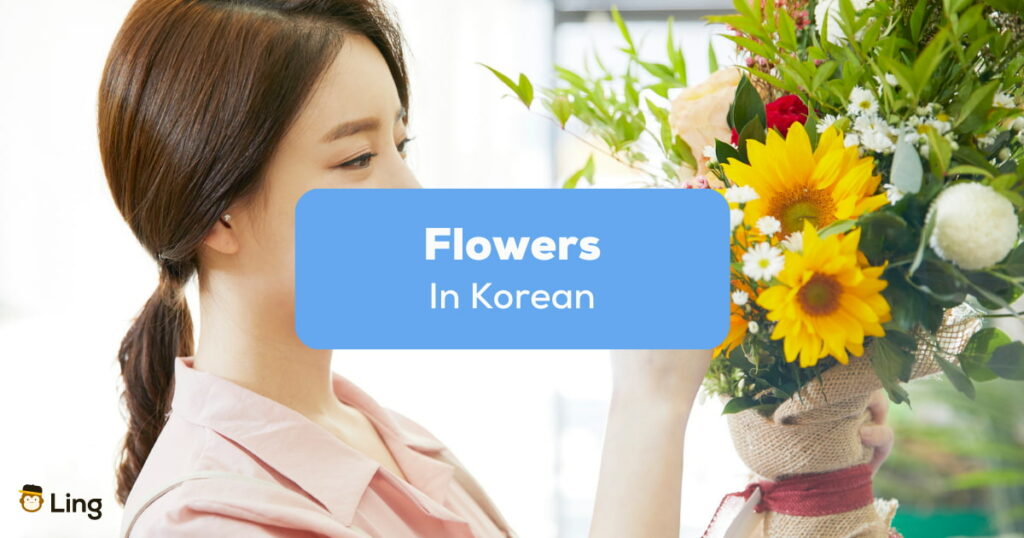While binge-watching K-dramas like Goblin, have you noticed how important flowers in Korean culture are? Today, let’s talk about flowers in Korean 꽃 (Kkot).
It’s amazing how flowers can symbolize something for Koreans. In Crash Landing On You, the edelweiss given by Captain Ri to Se-ri symbolizes courage. The buckwheat flower given by the Goblin Kim Shin to Eun-tak means a lover, and the evening primrose gifted to Goo Chan-Sung in Hotel del Luna symbolizes youth, eternal love, and memory.
In this blog, we will learn Korean flower names and Korean words, and Korean phrases related to flowers. If you are still new to the Korean alphabet or the Korean language itself, do not worry because there is an English translation for every Korean word mentioned. You can also start learning Korean with the Ling app and see how it can make magic happen.
How To Say Flower In The Korean Language
The Korean word for flower is 꽃 (Kkot). As you may have seen, the word ends with ㅊ(with the “t” sound). This means that when you combine it with an object or a noun that denotes particles, you’ll say 꽃을 (kkocheul) or 꽃이 (kkochi).
꽃 (Kkot) – Flower

If you’re a beginner, it’s not easy to read Korean at first. But, as soon as you have understood the Korean writing system and the pronunciation of every word, you’ll realize that Korean is indeed an easy language to learn compared to other East Asian languages like Chinese and Japanese. So, why not learn Hangeul today?
Flowers In South Korea: 8 Korean Flowers And Their Symbolic Meanings
South Korea is undoubtedly one of the most beautiful places, especially during the spring and autumn seasons. Some say that these are the best times to visit South Korea, especially if you want to see flowers blooming or cherry blossoms 벚꽃 (Beotkkot) during beautiful autumn foliage.
As mentioned above, flowers have a significant role in Korean culture. It is used on special occasions like celebrations and memorials. Since growing flowers isn’t that hard because of South Korea’s weather, it’s no surprise that flowers have always been part of their lives. So, here is a complete list of common flowers in Korean:

1. 무궁화 (Mugunghwa)
English Translation: Rose of Sharon or Hibiscus Syriacus
If you have been wondering which is the most popular flower in Korea, this is it! Our list of flowers in the Korean culture starts with South Korea’s national flower: “Hibiscus Syriacus” or the Rose of Sharon (무궁화 Mugunghwa). This beautiful pink-mauve single flower with dark magenta eyes will drive you in by its beauty, but also by its meaning: “Eternal blossom that never fades.” In short, this flower symbolizes everlasting life.
If you are a fan of the Korean series Squid Game, you might have heard this because of the song “The Mugunghwa Flower Is Blooming.” There’s also a train operated by Korail that runs in South Korea bearing the name of their national flower (Mugunghwa-ho).
2. 벚꽃 (Beotkkot)
English Translation: Cherry Blossoms / Cherry Blossom Trees
When we talk about flowers in Korean, it’s impossible not to talk about cherry blossoms. Many iconic romantic K-drama scenes have the presence of a cherry blossom that makes everything so romantic. Every April, cherry blossoms bloom down the street, creating a scene that appears exactly like the romance scenes in Korean dramas.
Although cherry blossom is mostly associated with Japan, the blooming of cherry blossoms marks the beginning of spring’s arrival in South Korea. There are lots of places in South Korea where you can enjoy cherry blossoms, like in Jinhae during the Jinhae Gunhangje Festival, in Hwagae during the Hwagae Cherry Blossom Festival, and of course, in Winter Sonata’s Nami Island (Chuncheon).

3. 장미 (Jangmi)
English Translation: Rose
Roses 장미 (jangmi) are commonly associated with love and romance. It is often gifted as a sign of love or appreciation to someone. But, roses have different meanings according to colors for Koreans. The orange rose symbolizes first love, the pink rose symbolizes happiness or lovers, and the red rose means passionate love.
4. 해바라기 (Haebaragi)
English Translation: Sunflower
Like the name itself, sunflower 해바라기 (haebaragi) symbolizes happiness because it helps brighten someone’s mood. For the best view of sunflowers, do not forget to visit Gangwon Province in Guwau Village, the city of Taebaek, during the month of August. You can also experience the Taebaek Sunflower Festival which is being held between July 24 to August 16.
5. 생사초 (Saengsacho)
English Translation: Resurrection Plant (Pyrenean Violet)
This is the flower that you wouldn’t want to be found easily in every Kingdom fan. This is a rare purple flower that is said to have the power to bring back the dead to life in the form of mindless, bloodthirsty zombies. But of course, this is all just part of the story.
In reality, the so-called resurrection plant is called Pyrenean violet. It is a kind of violet (제비꽃 jebikkot) flower famous in South Korea. Just like what is mentioned in the series Kingdom, Pyrenean Violet survives in its naturally cold habitat, but it can never turn someone into a zombie in reality.
6. 매화 (Maehwa)
English Translation: Plum Blossom
In Korea, plum blossoms are also regarded as one of the first signs of spring. Plum blossoms have a soft and wonderful appeal as a dazzlingly beautiful Korean spring flower. The delicate white or pink petals with golden stamens create a wonderful harmony. Plum blossom is best viewed by the tourists in Gwangyang village during mid to late March.
7. 산수유 (Sansuyu)
English Translation: Cornelian Cherry Flower
The Cornelian cherry flower is one of the famous flowers in Korean culture because it blooms everywhere during springtime. This bright yellow-colored flower means immortality. Koreans also use this in making medicine, tea, and more. Suppose you want to see the beauty of the Cornelian cherry flower. In that case, you can visit Gurye, Yangpyeong in the months of July to September or attend the Gurye Sansuyu Festival and Yangpyeong Sansuyu Hanwoo Festival.
8. 유채꽃 (Yuchaekkot)
English Translation: Rapeseed flower (Canola Flower)
The rapeseed flower is called the queen of Jeju island during the spring season. This flower can turn Jeju Island into a beautiful and romantic scene that relieves stress and makes you feel so wonderful. There are different festivals held for rapeseed flowers, and one of them is the Jeju Canola Flower Festival (제주유채꽃 축제 jejuyuchaekkot chukje). If you wanna experience it by yourself, you can visit Jejudo, Daejeo, or Guri from late March to early May.
Other Flowers In Korean
| English Translation | Korean (Hangul) | Romanization |
| begonia | 베고니아 | begonia |
| camellia | 동백꽃 | dongbaekkkot |
| orchid | 난 | nan |
| daffodil | 수선화 | suseonhwa |
| golden bell tree (forsythia) | 개나리 | gaenari |
| sunflower | 해바라기 | haebaragi |
| poppy | 양귀비 | yanggwibi |
| tulip | 튤립 | thyullib |
| azalea | 진달래 | jindallae |
| violet | 제비꽃 | jebikkot |
| lily | 백합 | baekhab |
Vocabulary Related To Flowers In Korean
| English Translation | Korean (Hangul) | Romanization |
| plant | 식물 | sigmul |
| garden | 정원 | jeongwon |
| flower garden | 꽃밭 | kkotbat |
| a bunch of flowers | 꽃 한 다발 | kkot han dabal |
| a flower arrangement | 꽃꽃이 | kkotkkoji |
| flower bouquet | 꽃다발 | kkotdabal |
| flower pot | 화분 | hwabun |
| the smell of flowers | 꽃향기 | kkocchyanggi |
| I picked up some flowers for you | 너한테 줄 꽃을 좀 꺾었어. | neohante jul kkocheul jom kkeokkeosseo. |
| The flowers bloomed early this year | 올해는 꽃들이 일찍 피었어요. | orhaeneun kkotdeuri iljjik pieosseoyo. |
| I will plant the flowers today | 오늘은 화초를 심을 거예요. | oneureun hwachoreul shimeul geoyeyo. |
Flower You Have Heard In K-dramas And Their Meanings
| Flowers | Korean (Hangul) | Meaning | K-Drama Reference |
| Anemone | 아네모네 anemone | Betrayal and Helpless Love, Loneliness | Backstreet Rookie |
| Aster | 과꽃 gwakkot | Precious memories | The Great Seducer |
| Baby’s Breath | 안개 꽃 angae kkot | Pure, eternal love | Winter Sonata |
| Bindweed Flower | 메꽃 mekkot | Drawn in slowly and deeply | Cheat On Me, If You Can |
| Bridal wreath | 조팝 나무꽃 jopopnamukot | Love Affairs in the Afternoon | True Beauty |
| Buckwheat Flower | 메밀꽃 memilkkot | Lover | Goblin |
| Camellia | 동백꽃 dongbaekkkot | I love you more than anyone else | Itaewon Class |
| China Pink | 패랭이꽃 paeraengikkot | Rejection | Backstreet Rookie |
| Christmas Rose | 크리스마스 장미 keuliseumaseu jangmi | I have nothing to give you | Uncontrollably Fond |
| Chrysanthemum | 국화 guk-hwa chrysanthemum | My feelings are sincere | Her Private Life |
| Cistus | 시스투스 siseutuseu | I Will Die Tomorrow | Love in Sadness |
| Cosmos | 코스모스 koseumoseu | I Love You | 20th Century Boy and Girl |
| Cotton Flower | 목화 moghwa | Maternal love | Goblin |
| Dahlia | 달리아 dallia | Your Love Makes Me Happy | Tale of the Nine-Tailed |
| Delphinium | 델피늄 delpinyum | I Will Make You Happy | The King: Eternal Monarch |
| Edelweiss | 에델바이스 edelbaiseu | Courage | Crash Landing On You |
| Evening Primrose | 달맞이꽃 dalmaji kkot | Memory | Hotel Del Luna |
| Forsythia | 개나리 gaenari | A deeper love | Touch Your Heart |
| Freesia | 프리지아 peurijia | New Beginning | Good Witch |
| Globe Amaranth | 글로브 아마란스 geullobeu amalanseu | Captivating and Unchanging Love | Move To Heaven |
| Hibiscus | 히비스커스 hibiseukeoseu | Noble friendship | Backstreet Rookie |
| Hyacinth Purple Hyacinth White Hyacinth | 히아신스 hiasinseu | Humble love Purple Hyacinth – Sorry White Hyacinth – I’m sorry. Please forgive me. | Move To Heaven Fluttering Warning 18 Again |
| Hydrangea (Red Hydrangea) | 수국 sugug | I Love You | Devilish Joy |
| Lily of the Valley | 은방울꽃 eunbangulkkot | Return To Happiness | Boys Over Flowers |
| Lisianthus | 리시안셔스 risiansyeoseu | Unchanging Love | Lovestruck in the City |
| Marigold | 금잔화 geumjanhwa | Sad Goodbye/ Love / Happiness Coming One Day | Here Comes Love |
| Protea | 프로테아 peurotea | Gratitude, Thanks, and Sending Sweet Love | Mystery Queen |
| Rosa multiflora (Wild rose) | 찔레꽃 jjillekkot | Longing for family, love between sisters | Prison Playbook |
| Rose | 장미 jangmi | Blue Rose – Miracle Green Rose – A Noble Love That Only Exists In Heaven Orange Rose – First Love Pink Rose – Happiness/Lovers Light Pink Rose – Only You Know How I Feel Red Rose – Passion /Passionate Love White Rose – Respect, Purity Red & White Rose – Making up | When My Love Blooms |
| Stock Flower | 스톡 플라워 seutog peullawo | Forever Beautiful | Her Private Life (2019) |
| Tea Bush Flower | 차 덤불 꽃 cha deombul kkot | Memories | The Legend of the Blue Sea |
| Trumpet Creeper Campsis radicans | 능소화 neungsohwa | Wait | Extraordinary You |
| Tulip | 튤립 thyullib | Red Tulip – Confession of Love White Tulip – Lost Love, Forgiveness, Broken Heart Yellow Tulip – Unrequited love/Vain Love | Hospital Playlist 2; Record of Youth |
| Zinnia | 백일초 baegilcho | Longing desire, remembrance | Mouse |

Keep Your Korean Vocabulary In Full Bloom
With the influence of Hallyu (한류 Hallyu) or the Korean wave, many people want to learn Korean. Binge-watching K-dramas or listening to K-pop music might help, but why not take it to the next level and explore language learning apps like the Ling app?
Ling app is a language learning platform where you can learn Korean and other languages using bite-size topics, mini-quizzes, games, grammar tips, dialogues, and even blog posts. For those who can’t afford to enroll in language courses or travel to Korea, the Ling app will give you a fantastic language-learning experience.
The journey of learning Korean with the Ling app is like growing flowers. You need to plant your seeds in the form of time and effort, be patient, and soon enough, your Korean language skills will be in full bloom. So, waste no time by downloading the Ling app on the Play Store or App Store and start learning Korean now!



































































